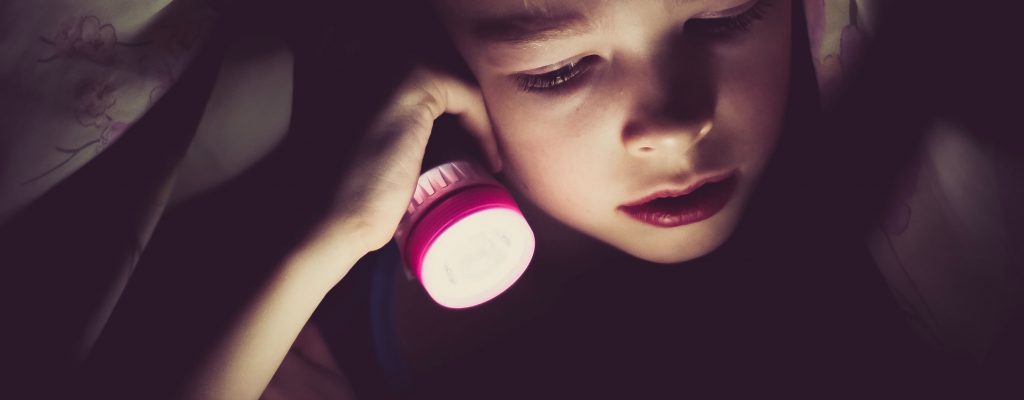Everyone wants their kids to get better sleep because if your kids are sleeping better, you are too.
But sometimes, we may be doing things like scrolling through our phones or using a sleeping light, that are keeping us from sleeping better and we don’t even realize it.
Turn Your Sleeping Light Off and Your Reading Light On
Check out these bedtime habits and see if you do any of them yourself. If so, it might be time to change things up a bit to give yourself a better night’s sleep.
No More Screen Time (Blue Light Exposure) Before Bedtime

Did you know?
Our phone and tablet screens emit a large amount of blue light which makes it more difficult to fall asleep.
According to the National Institute for General Medical Sciences, our bodies have a circadian rhythm, which is our “physical, mental, and behavioral changes that follow a daily cycle. They respond primarily to light and darkness in an organism’s environment.” Light is made of a wide spectrum of different colors, and science has found that each color in the spectrum actually creates a physiological response in our body. Artificial lighting has the same effect, but being exposed to the wrong artificial lighting at the wrong time of day can have a dramatic impact on how we feel and function.
For example, blue light is most prevalent in the sun’s natural spectrum from morning to mid-day, when our bodies are expected to be most productive. This means that when we stare at the blue light on our phones just before bed, the light is actually telling our bodies to wake up! The opposite of what we want for a healthy and regular sleep schedule.
The effects of blue light on sleep are pretty huge. If you or you kids are in the habit of scrolling right before bed, it might be time to change that routine.
Another study explains that a great way to help yourself get better sleep even when you are exposed to blue light is to “block the (blue) light from technology that suppresses melatonin.”
Melatonin is a hormone in our bodies that helps regulate sleep and if blue light is keeping our bodies from creating and using it, then we’re going to have a harder time falling asleep.
So ditch the phone scrolling before and try these ideas instead:
- Plugin your phone across the room so you’re not tempted to continuously scroll at bedtime
- Set a reminder on your phone when it’s time to go to put down your phone and go to bed
- Try using a blue light filter if you do have to use a screen before bed or blue light blocking glass right before bed
- Change the light bulbs in your bedroom fixtures to be sure they are not emitting high amounts of blue light (look for 2700K or less)
To reduce the amount of blue light you’re exposed to, be sure to upgrade the bulbs in your bedrooms to utilize the best lights for sleeping.
Use these warmer LED light bulbs instead!
Use Low Level Lighting

Once you have the right bulbs with low blue light, before going to bed, consider dimming the lights in your bedroom. It is best if this is done with an eye level lamp or wall sconce. Using this pattern does more to mimic the natural light changes of the sun.
Doing this will help communicate to your body that it’s time to get ready for bed and help you wind down for the evening. Using a bright overhead light, signal to our body that its time to be productive. Cutting it off suddenly does little to help our body understand it’s now time to begin making the chemicals required for good sleep.
If nothing else, try adding a simple dimmer switch to your main light and dim the lamps to about 30% as you wind down at night before bed.
Night Lights Matter
Many children (an adults) go to bed with a sleeping light on, but keeping the lights off at night can actually help you stay asleep better and wake up feeling more refreshed.If a night light is needed, Instead of using a normal light bulb, again try switching to low-level, warm-toned lights (2700K or lower) with a low blue light rating and see what a difference it makes in how well you sleep.
Be More Aware of the Lights in Your Home
You might think a light bulb is a light bulb, but it’s far from the truth. As you know now, the type of bulb makes a big difference in how we feel. Do you know what kind of light bulbs you have in your home?
SeniorLed claims that “Low blue light bulbs are notably better than typical LED bulbs in terms of circadian cycle regulation and human health.”
If your lightbulbs are out of date, they could be affecting your sleep. Things like harsh fluorescent lighting, that flicker a lot, and has high blue light emissions can be unsettling to your eyes making it harder to fall asleep after being exposed to them all day.
Instead of fluorescent lights, try these LED bulbs for home lighting instead. Need somewhere to start? Begin changing out the lighting in your bedrooms for a better night’s sleep.
About Us
For all your home lighting needs, visit Lit Living. Our lighting experts can help you optimize any room with the best lighting for a healthier, happier home.


















